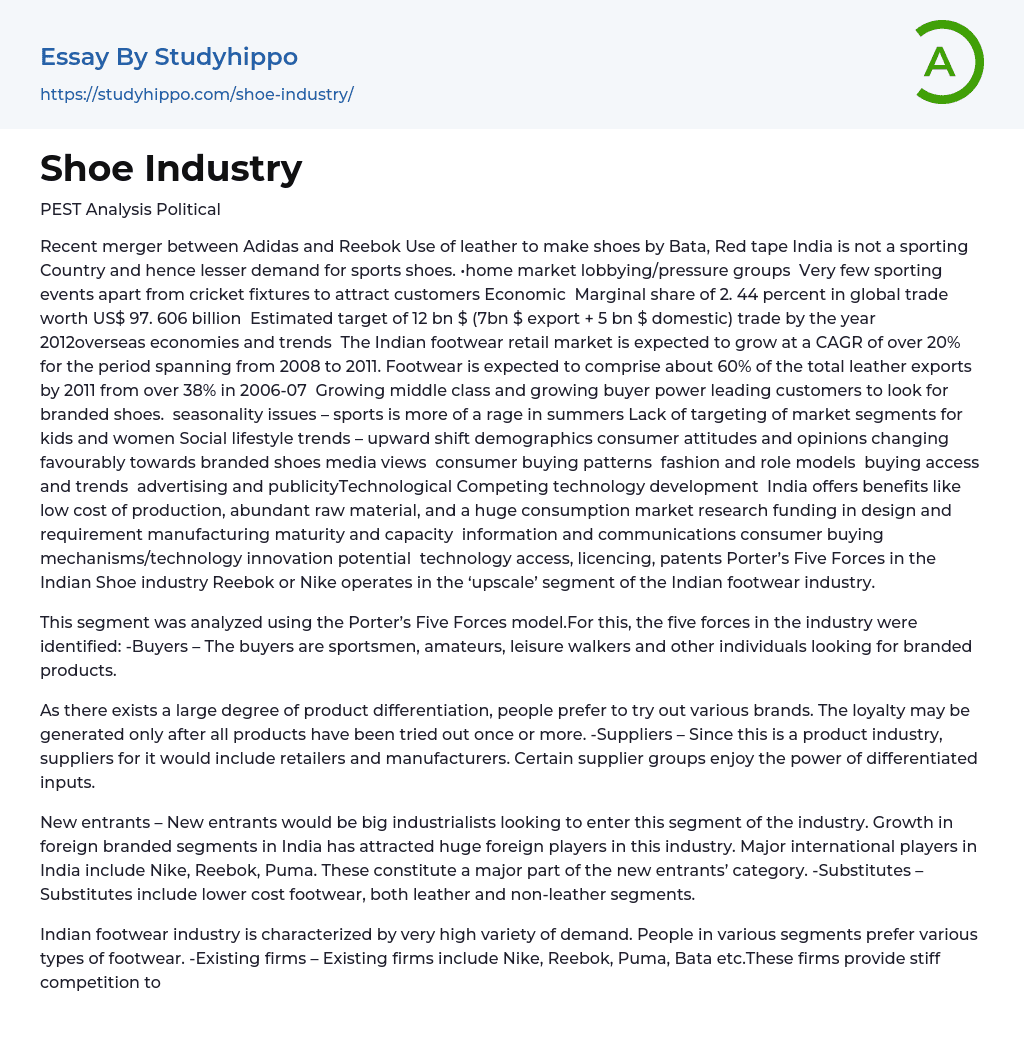PEST Analysis Political
Recent merger between Adidas and Reebok
Use of leather to make shoes by Bata
Red tape in India causing difficulties for businesses
India has a lesser demand for sports shoes due to the country not being known for sporting events other than cricket fixtures.
Home market lobbying/pressure groups present challenges
Economic
India has a marginal share of 2.44 percent in global trade worth US$ 97.606 billion
The estimated target is to achieve a trade worth $12 billion by 2012 through both exports ($7 billion) and domestic sales ($5 billion).
Overseas economies and trends are influencing the Indian footwear retail market, which is expected to grow at a CAGR of over 20% from 2008 to 2011.
Footwear is projected to comprise approximately 60% of total leather exports by 2011, compared to 38% in 2006-07.
This growth can be attributed to the expanding middle class and their increased purchasing power, leading to higher demand
for branded shoes.
The popularity of sports during the summer months also contributes to seasonality in shoe sales.
However, there is currently a lack of focus on market segments for children and women, despite changing social lifestyle trends and consumer attitudes towards branded footwear.
Media views, consumer buying patterns, fashion trends, and role models all influence customer purchasing decisions.
Furthermore, rapid technological development within the industry presents both challenges and opportunities.India's advantages in terms of low production costs, abundant raw materials, and a vast consumer market contribute to the potential for innovation in the shoe industry. Additionally, research funding, manufacturing capabilities, and advancements in information and communications technology further enhance this potential. To examine the high-end segment of India's footwear industry, the Porter's Five Forces model was applied. This model identified variou
forces within the industry such as buyers encompassing sportsmen, amateurs, leisure walkers, and those seeking branded products.
Due to the existence of extensive product differentiation, individuals tend to prefer experimenting with different brands. Loyalty towards a particular brand may only be developed after trying all products at least once. Suppliers in this industry typically include retailers and manufacturers, with some supplier groups benefiting from having unique inputs. New entrants refer to influential industrialists seeking to penetrate this specific sector of the market. The expansion of foreign-branded segments in India has enticed major international players to enter this industry.
Major international players in India, such as Nike, Reebok, and Puma, represent a significant portion of the new entrants' category. In addition, substitutes in the Indian footwear industry, including lower-cost leather and non-leather options, contribute to the diverse demand. Furthermore, existing firms like Nike, Reebok, Puma, and Bata face intense competition and strive to distinguish their products to foster customer loyalty.
Summary: The figure above rates each of the five forces in the shoe industry on a scale of 1 to 5 to determine the level of threat they pose to players in the industry. On initial analysis, all five forces appear to pose a similar level of threat, around three. However, further examination reveals that the degree of rivalry among existing firms, supplier power, and the threat of new entrants present slightly greater threats compared to substitutes and buyer power, as shown in the figure.
- Chief Executive Officer essays
- Convenience Store essays
- Firm essays
- Training And Development essays
- Unilever essays
- Variable Cost essays
- Virgin Group essays
- Bargaining essays
- Entity essays
- Pest analysis essays
- Automotive essays
- Real Estate essays
- Construction essays
- E Commerce essays
- Commerce essays
- Polymers essays
- Automotive Industry essays
- Paper Industry essays
- Textile Industry essays
- Pharmaceutical industry essays
- Pharmacy essays
- Grocery stores essays
- Classical Mechanics essays
- Rail Transport essays
- Tata Motors essays
- Vehicle Brands essays
- trucks essays
- Auto Racing essays
- Harley-Davidson essays
- Suzuki essays
- Lexus essays
- Mercedes-Benz essays
- Buying Homes essays
- Futures Contract essays
- Mortgage Loan essays
- Renting essays
- Transaction Cost essays
- Building essays
- Optical Fiber essays
- Freezing essays
- Polymer essays
- Weaving essays
- Advertising essays
- Audience Theory essays
- Competitor Analysis essays
- Consumer essays
- Marketing Management essays
- Marketing Mix essays
- Marketing Plan essays
- Marketing Research essays




